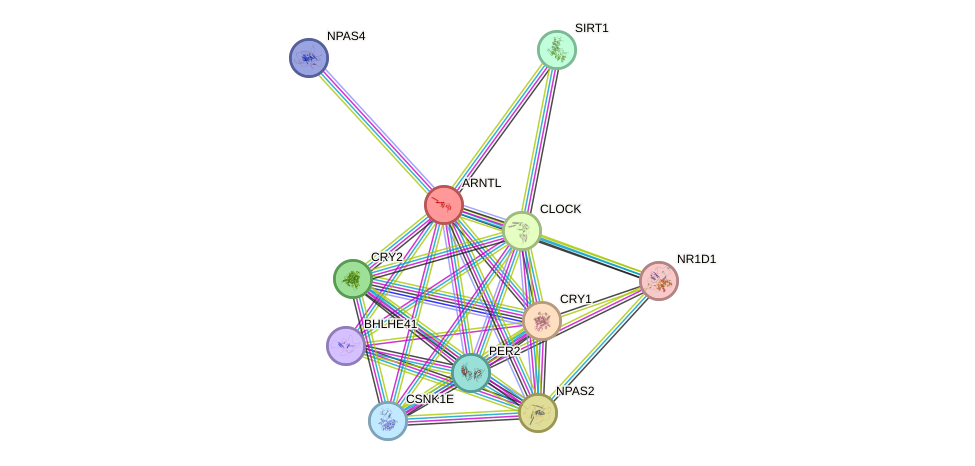GenAge entry for ARNTL (Homo sapiens)
Entry selected based on evidence directly linking the gene product to ageing in a mammalian model organism
Gene name (HAGRID: 251)
- HGNC symbol
- ARNTL
- Aliases
- MOP3; JAP3; BMAL1; PASD3; bHLHe5
- Common name
- aryl hydrocarbon receptor nuclear translocator-like
Potential relevance to the human ageing process
- Main reason for selection
- Entry selected based on evidence directly linking the gene product to ageing in a mammalian model organism
- Description
ARNTL forms a heterodimer with CLOCK, which activates circadian rhythm-associated genes. Mice deficient in ARNTL have an impaired circadian behavior, reduced lifespan, and display symptoms of premature ageing associated in some tissues with increased levels of reactive oxygen species [1841]. BMAL1 deficient mice also have an increased activity of mTORC1, and treatment with rapamycin rescues their median lifespan by ~50% and maximum lifespan by ~25% [3627].
Cytogenetic information
- Cytogenetic band
- 11p15
- Location
- 13,277,727 bp to 13,387,265 bp
- Orientation
- Plus strand
Protein information
- Gene Ontology
-
Process: GO:0000060; protein import into nucleus, translocation
GO:0006355; regulation of transcription, DNA-templated
GO:0006366; transcription from RNA polymerase II promoter
GO:0007283; spermatogenesis
GO:0007623; circadian rhythm
GO:0032007; negative regulation of TOR signaling
GO:0032922; circadian regulation of gene expression
GO:0042176; regulation of protein catabolic process
GO:0042634; regulation of hair cycle
GO:0042753; positive regulation of circadian rhythm
GO:0043161; proteasome-mediated ubiquitin-dependent protein catabolic process
GO:0045599; negative regulation of fat cell differentiation
GO:0045892; negative regulation of transcription, DNA-templated
GO:0045893; positive regulation of transcription, DNA-templated
GO:0045944; positive regulation of transcription from RNA polymerase II promoter
GO:0050767; regulation of neurogenesis
GO:0050796; regulation of insulin secretion
GO:0051726; regulation of cell cycle
GO:0051775; response to redox state
GO:0060137; maternal process involved in parturition
GO:0090263; positive regulation of canonical Wnt signaling pathway
GO:0090403; oxidative stress-induced premature senescence
GO:2000074; regulation of type B pancreatic cell development
GO:2000323; negative regulation of glucocorticoid receptor signaling pathway
GO:2000772; regulation of cellular senescence
GO:2001016; positive regulation of skeletal muscle cell differentiation
Cellular component: GO:0005634; nucleus
GO:0005654; nucleoplasm
GO:0005667; transcription factor complex
GO:0016605; PML body
GO:0033391; chromatoid body
GO:0043231; intracellular membrane-bounded organelle
Hide GO termsFunction: GO:0000976; transcription regulatory region sequence-specific DNA binding
GO:0000982; transcription factor activity, RNA polymerase II core promoter proximal region sequence-specific binding
GO:0001046; core promoter sequence-specific DNA binding
GO:0001047; core promoter binding
GO:0001190; transcriptional activator activity, RNA polymerase II transcription factor binding
GO:0003677; DNA binding
GO:0005515; protein binding
GO:0017162; aryl hydrocarbon receptor binding
GO:0043425; bHLH transcription factor binding
GO:0043565; sequence-specific DNA binding
GO:0046982; protein heterodimerization activity
GO:0051879; Hsp90 protein binding
GO:0070491; repressing transcription factor binding
GO:0070888; E-box binding
Protein interactions and network
- Protein-protein interacting partners in GenAge
- CREBBP, HIF1A, HSP90AA1, EP300, SIRT1, PPP1CA, CSNK1E, CLOCK
- STRING interaction network
Retrieve sequences for ARNTL
Homologs in model organisms
In other databases
- GenAge model organism genes
- A homolog of this gene for Mus musculus is present as Arntl
- GenDR gene expression
- A homolog of this gene for Mus musculus is present as Arntl
- LongevityMap
- This gene is present as ARNTL

